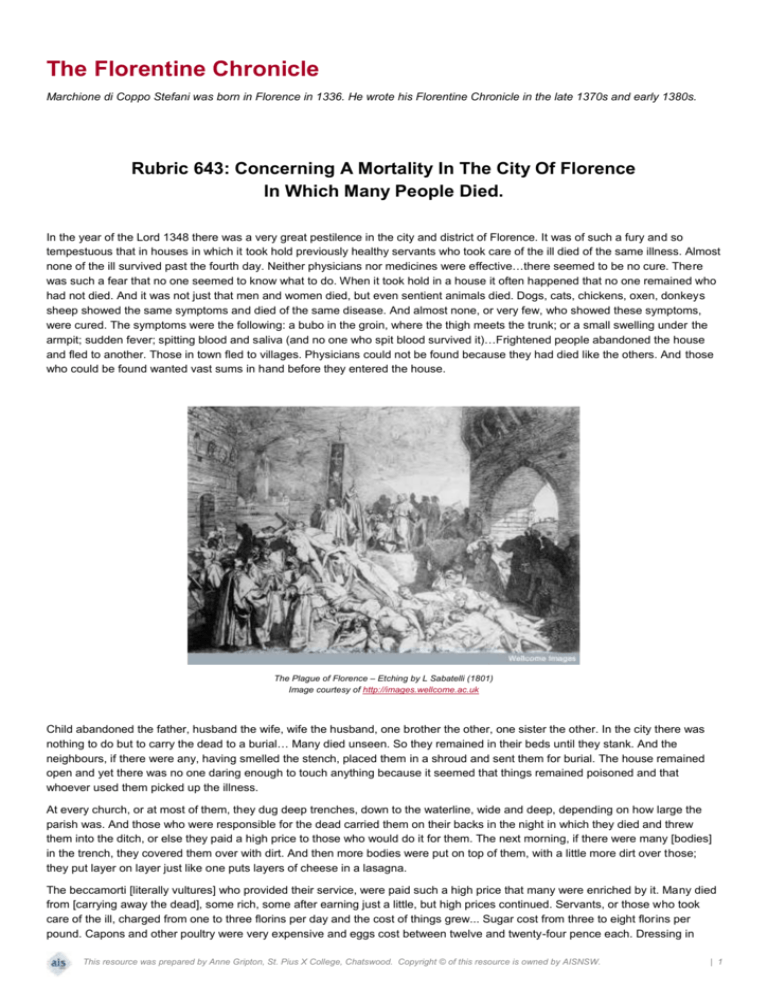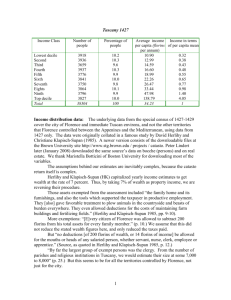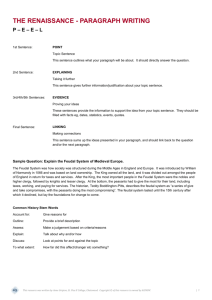The Florentine Chronicle Source
advertisement

The Florentine Chronicle Marchione di Coppo Stefani was born in Florence in 1336. He wrote his Florentine Chronicle in the late 1370s and early 1380s. Rubric 643: Concerning A Mortality In The City Of Florence In Which Many People Died. In the year of the Lord 1348 there was a very great pestilence in the city and district of Florence. It was of such a fury and so tempestuous that in houses in which it took hold previously healthy servants who took care of the ill died of the same illness. Almost none of the ill survived past the fourth day. Neither physicians nor medicines were effective…there seemed to be no cure. There was such a fear that no one seemed to know what to do. When it took hold in a house it often happened that no one remained who had not died. And it was not just that men and women died, but even sentient animals died. Dogs, cats, chickens, oxen, donkeys sheep showed the same symptoms and died of the same disease. And almost none, or very few, who showed these symptoms, were cured. The symptoms were the following: a bubo in the groin, where the thigh meets the trunk; or a small swelling under the armpit; sudden fever; spitting blood and saliva (and no one who spit blood survived it)…Frightened people abandoned the house and fled to another. Those in town fled to villages. Physicians could not be found because they had died like the others. And those who could be found wanted vast sums in hand before they entered the house. The Plague of Florence – Etching by L Sabatelli (1801) Image courtesy of http://images.wellcome.ac.uk Child abandoned the father, husband the wife, wife the husband, one brother the other, one sister the other. In the city there was nothing to do but to carry the dead to a burial… Many died unseen. So they remained in their beds until they stank. And the neighbours, if there were any, having smelled the stench, placed them in a shroud and sent them for burial. The house remained open and yet there was no one daring enough to touch anything because it seemed that things remained poisoned and that whoever used them picked up the illness. At every church, or at most of them, they dug deep trenches, down to the waterline, wide and deep, depending on how large the parish was. And those who were responsible for the dead carried them on their backs in the night in which they died and threw them into the ditch, or else they paid a high price to those who would do it for them. The next morning, if there were many [bodies] in the trench, they covered them over with dirt. And then more bodies were put on top of them, with a little more dirt over those; they put layer on layer just like one puts layers of cheese in a lasagna. The beccamorti [literally vultures] who provided their service, were paid such a high price that many were enriched by it. Many died from [carrying away the dead], some rich, some after earning just a little, but high prices continued. Servants, or those who took care of the ill, charged from one to three florins per day and the cost of things grew... Sugar cost from three to eight florins per pound. Capons and other poultry were very expensive and eggs cost between twelve and twenty-four pence each. Dressing in This resource was prepared by Anne Gripton, St. Pius X College, Chatswood. Copyright © of this resource is owned by AISNSW. | 1 expensive woollen cloth that used to cost women three florins climbed in price to thirty florins and would have climbed to 100 florins had the custom of dressing in expensive cloth not been changed. Benches on which the dead were placed cost like the heavens and still the benches were only a hundredth of those needed. Priests were not able to ring bells as they would have liked. Concerning that [the government] issued ordinances discouraging the sounding of bells, sale of burial benches, and limiting expenses. None of the guilds in Florence was working. All the shops were shut, taverns closed; only the apothecaries and the churches remained open. If you went outside, you found almost no one. This mortality enriched apothecaries, doctors, poultry vendors, beccamorti, and greengrocers who sold of poultices to draw off the infirmity. Woolworkers and vendors of remnants of cloth who found themselves in possession of cloths [after the death of the entrepreneur for whom they were working] sold it to whoever asked for it. When the mortality ended, those who found themselves with cloth of any kind or with raw materials for making cloth was enriched. This pestilence began in March, as was said, and ended in September 1348. They found that among males, females, children and adults, 96,000 died between March and October. And people began to return to look after their houses and possessions. And there were so many houses full of goods without a master that it was stupefying. Then those who would inherit these goods began to appear. And such it was that those who had nothing found themselves rich with what did not seem to be theirs and they were unseemly because of it. Women and men began to dress ostentatiously. The tailors made such boundless demands for payment that they could not be satisfied. Servants were so unhappy about the very high prices [they paid] that it was necessary to make great efforts to restrain [the price rises]. The workers on the land in the countryside wanted rent contracts such that you could say that all they harvested would be theirs. And they learned to demand oxen from the landlord but at the landlord's risk [and liability for any harm done to the animal]. From the University of Virginia http://www2.iath.virginia.edu/osheim/intro.html This resource was prepared by Anne Gripton, St. Pius X College, Chatswood. Copyright © of this resource is owned by AISNSW. | 2 Use the information from this source to consider the impact of the Plague on Naples. Positive Price Rises Negative i.e. think about the Merchants who sold produce Doctors i.e. think about how it affected families, friends, the wider community Social Order/Structure Government i.e. what did the government do to help the situation? Religion List TWO reasons why historians might think that Marchione di Coppo Stefani’s writing is RELIABLE? List TWO REASONS why historians might think that Marchione di Coppo Stefani’s writing is UNRELIABLE? What other sources would help us determine its reliability? This resource was prepared by Anne Gripton, St. Pius X College, Chatswood. Copyright © of this resource is owned by AISNSW. | 3











